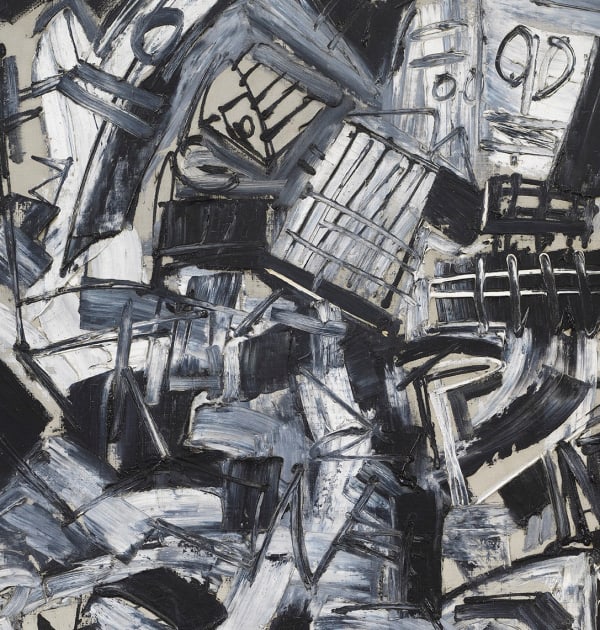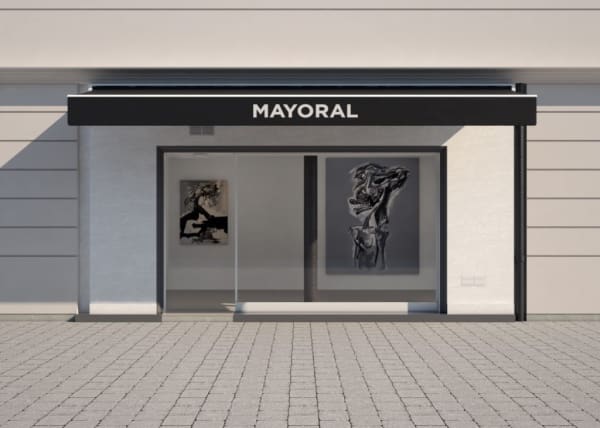Mayoral is delighted to open a new gallery in Paris with an exhibition devoted to Antonio Saura, "Brigitte Bardot et autres dames". Curated by art informel expert Martine Heredia, the exhibition presents six historic paintings inspired by the female figure created between 1956 and 1962.
Antonio Saura, like Picasso, makes of the figure of the woman less a theme of predilection than a field of research. From 1954 on he envisages her as the mother form—the matrix—as a mould out of which form will emerge, as a breast that gives birth to an other image.
The Damas are, then, incipient structures through which Antonio Saura works towards a deformation of form, the aim being to decompose it in order to vacate space and thus create a new space. Treated with a violence that is not chromatic but gestural, the Damas are painted with broad strokes of the brush or palette knife which sweep the surface to the very edge (Nule, 1958). The canvas is the locus of the combat with matter; the pastes and pigments the artist mashes together when working up the initial figure and unmaking it are the protagonists of the metamorphosis, enablers of the transition from the magma to that which will engender the work of art. The canvas is this locus of energy in which matter sets about existing, this locus that accommodates two actions and in which, in a hand-to-hand fight between matter and paint, it grants existence to man.
This is why the formless is not just the matrix of form, but movement; it is a force of transgression, experimentation, invention. The image these Damas emit has nothing to do with the ideal muse of classical art; the wish to have done with the canons is blatant. Goddesses without bodies and lacking a name; they refer to primordial mystery. The image is the one that is loaded with symbolic or phantasmatic value, which traces its origins in the awareness of sin and in the unconscious; the ambiguity of the word Dama oscillates, moreover, between vice and virtue, between Virgin and whore. A vision of woman as the great universal monster in which destruction and creation are ensconced, and which the 1950s have prolonged with the myth of the femme fatale.
Towards the end of the decade, at the same time as he gives them a name, Antonio Saura gives them a body, barely sketched in (Stima, 1959). With Brigitte Bardot he takes on an icon; the mouth and eyes deform the face, letting teeth and eyes sockets be seen, and they transform the sex symbol into a monster, half-woman, half-beast (Brigitte Bardot, 1960-61). Pendulous lips or prolongation of the backbone, the mouth becomes the maw of an animal (Brigitte Bardot, no. 6, 1959). “The greater the beauty is, the greater the defilement,” writes Bataille; Saura deconstructs the B.B. myth and, in desacralizing it, creates a new monster, another face of a single image. In order to destroy Beauty he perverts its form, disfiguring the model, causing the norm and its deviation, the ideal of beauty and its counter-ideal, to coexist. In order to reject the canons he gives free rein to non-knowledge and, if beauty must be convulsive, it is because in his hands the object of desire is transformed into a pure aesthetic object; once sacrificed, the icon opens onto the totally other.
In Saura the treatment of the woman marks, in point of fact, the irruption of the frightening in the beautiful, which is deemed to be art, by a movement of the formless which leads to a shuttling between attraction and repulsion. The formless echoes the monstrosity that subtends the brutality, the violence, of the treatment inflicted upon the figure; for if the artistic monster is that which occurs materially on the surface of the canvas, it is also that which the artist causes to be, from a subterranean power that he will draw from deep within himself. Accordingly, it is a matter of forms and of forces. Anthropomorphic creatures that loom up frontally, Saura’s Damas have but little to do with the human; the eye of the painter seeks after, instead, the animality in woman, her intimate stripping bare. And if, when they look at us, they yet beckon to us today, it is because they refer us to our own animality. In pushing form as far as the obscenity of the formless, Saura gives us a dislocated view of these faces in which resemblance is distorted, in which the pictorial discharge and the rage of desire is concentrated on the head, in which the violence of the rhythm drives the identifiable elements into unexpected places (Brita, 1956), with the aim of acceding to the hidden part of being. The monstrous forms of Saura are the product of painting’s cruelty, which obliges the painter to destroy the image, in order to transform and thus to re-appropriate it. This is why contemplation of the monster is superseded in order to privilege the monstrosity that subtends it; what peeks through, then, is the non-representable [l’infigurable] itself.
Exhibition curated by Martine Heredia.












